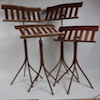Still working on running long pieces as well as sheets through the table saw completely straight. I get a little wiggle as it goes through. As you can see in the pic, still practicing and learning as you can tell by the burn marks. 2 HP Shop Fox cabinet saw with stock fence, 10" Forrest WWII blade, first project it's been used on.
Working with 5'x5' Baltic Birch sheets for a project, ran through at 16" to then rip down to 2.5" strips with the smaller sheet. Still got a little movement running it through as seen in the pic below after I cut the rips down to size for some shaker rail and stiles.
IMG_2311.jpg
What's the proper way to even these out? Run through the table saw again at a slightly narrower size? Plane them even?




 Reply With Quote
Reply With Quote




